Introduction
Gonadotropin releasingGonadotropin-releasing hormones (GnRHs) are decapeptides produced from specialized neurosecretary neurosecretory cells in the hypothalamus, targeting the pituitary-gonadal axis. Over 20 different forms of GnRH in vertebrateinvertebrate species have highly conserved structurestructures. In mammals, three forms are known, GnRH-I (mammalian GnRH), GnRH-II (chicken GnRH-II), and the salmon GnRH (RnRH-III) (Metallinou et al., 2007). GnRH-I is a typical pituitary controlling hormone, with affinity to the pituitary seven transmembraneseven-transmembrane domain G protein (Gq/11)-coupled receptors (Stanislaus et al., 1997).
After binding, GnRH-I modulates membrane phospholipase C (inositol phosphate) and calcium channel, and consequently, it stimulates LH synthesis and secretion. A directDirect control over FSH secretion has not been unequivocally proven. Plasma gonadotropin levels regulate the overall reproductive process, especially the gonadal steroidogenic and gametogenic functions (Millar, 2005). GnRH-II, besides pituitary gonadotropin stimulation, also impacts on neural development and sexual arousal in the hypothalamus region. The GnRH-I and II receptors are also found in almost all types of normal and cancerous epithelial cells, including those present in gonads (Millar et al., 2001).
The extra-pituitary function of these receptors in these tissues is not fully understood, but evidence suggests that the GnRH-I and II signal transduction pathways in epithelial tissues are different from pituitary cells (Emons et al., 2003). Interestingly, GnRH-II receptors in these epithelia have conserved regions of GnRH-I, and binding of the two GnRHs to their receptors can be mutually exclusive (Manputha et al., 2007). Studies suggest that GnRH-II has a role in neuromodulation, regulation of energy intake, and suppression of cell proliferation and apoptosis by triggering a G-protein (Gi) mediated signal pathway in the target cells (Szkudlinski, 2007).
During the last four decades, several thousand peptide peptides and non-peptide GnRH agonists and antagonists have been synthesized and tested for clinical efficacy. These compounds, which are generally GnRH analogs, competitively bind to pituitary GnRH receptors and by two distinct mechanisms down-regulate gonadotropin synthesis and secretion. Within 7-14 days of a GnRH agonist administration, a “surge” of gonadotropins and steroidal hormones, known as “flare”, is followed by a rapid fall in their serum concentrations. On the other hand, the antagonists lower the hormone concentrations from the beginning. Both groups of synthetic analogs also down-regulate the expression of GnRH receptors and initiate the internalization of the cell surface receptors to the nuclear membrane (Herbst, 2003). This further hinders the binding of GnRH to pituitary cells.
Clinically, the agonists/antagonists are used for the treatments of prostatic, breast, and endometriotic cancers, uterine fibroids, precocious puberty, premenstrual and polycystic syndromes, and infertility (Emons et al., 2003; Millar, 2005; Hayden, 2008). During 90’s the ’90s Antarelix has been formulated and extensively used as a polypeptide GnRH-I antagonist (Deghengh et al., 1993). The advantage of this drug has been its high water solubility, modest allergy and histamine stimulation, and high potency.
Because they have similar patterns of serum β-estradiol, progesterone, testosterone, LH/CG during the ovulatory cycle and pregnancy to that of the human being, nonhuman primates are used as experimental models to rectify hormone-related reproductive problems like anovulatory infertility (Steinetz et al., 1995; Abbott et al., 2004). Among primates too, the reproductive physiology of Old World (e.g. rhesus; Macaca mulatta) and New World (marmosets; Callithrix jacchus) monkeys differs. Some ubiquitous features of marmoset distinct from higher primates are:
- multi-ovular species with ovulatory cycles of ~28 days, comprising short follicular (8-9 days) and long luteal (19 days) phases,
- ovulation rates ranging from one to four follicles per cycle (Gilchrist et al., 2001),
- pituitary gonadotropes secret chorionic gonadotropin (CG) and not LH,
- LH receptors bind to CG and course of action of two hormones is similar (Tannenbaum et al 2007), and
- ovarian senescence is more subtle and does not resemble the menopause in women.
Like As humanhumans, the follicular phase is characterized by a low level of progesterone, rising estradiol, and a typical pre-ovulatory “surge” of LH, in the form of CG. Marmoset ovaries contain a multitude of small antral follicles and towards the end of the follicular phase; two or three antral follicles enlarge and go on to ovulate. There exists a clear morphological and size distinction between large ovulating and small non-ovulating antra (Gilchrist et al., 2001). Ovarian epithelial proliferation is believed to be primarily regulated at the level of gonadotropins, which stimulate follicular estradiol production.
As a mitogen, β-estradiol and other localized factors such as insulin-like and hepatocyte-growth factors (IGF, HGF) trigger a proliferative response in the post-ovulatory OSE layer at the sites of rupture. Poly-ovulating mammals like marmosets have repeated ovulations ovulation and therefore repeated rupture and healing of the OSE layer. These features accelerate OSE cell multiplication and transformation to neoplastia neoplasia at the rupture sites.
Notwithstanding, gonadotropin-associated incidences of ovarian cancers are rarely reported in marmosets, even though EOC affects only primates and no other mammals. It is likely that about 10-fold higher progesterone concentration in pregnant marmosets compared to other primates (Steinetz et al., 1995) help suppress the OSE tumorigenesis in these animals.
Antarelix GnRH antagonist has been used in marmosets to suppress LH/CG secretion from the pituitary gland and the follicular and luteal development was examined in such treated animals (Taylor et al., 2004). It was found that upon such treatment the serum β-estradiol rapidly falls and as a result proliferation of granulosa cells in antrum and CL diminishes. More importantly, follicular vasculature remained underdeveloped and the resultant follicle’s growth and differentiation gets get stunted and ovulation becomes unsuccessful. The GnRH antagonists may also suppress the mammalian OSE proliferation and tumorigenesis in a dualistic manner.
First, it may do so by inhibiting LH/CG secretion so that follicular development and ovulation gets affected. Hence the number of re-epithelization events is reduced and OSE stays non- proliferativenon-proliferative. Second, the antagonists may bind directly to OSE cells GnRH receptors and impart anti-proliferative response through some unknown downstream signaling pathway. Another action could be that reduced LH-controlled steroidogenesis brings down the production of localized pro-proliferative mitogens (β-estrogen) in granulosa cells and other inflammatory agents which cause genetic damage to the epithelial cells.
According to the gonadotropin theory of ovarian cancer, a high level of gonadotropins at menopause has a role in the development of epithelial ovarian cancer. In this study, we test the hypothesis that a standard GnRH antagonists administration would suppress endogenous gonadotropin, resulting in inhibition of OSE proliferation in marmoset. We also hypothesize that changes in the ovarian environment during the ovarian cycle (follicular and luteal phase) and at early pregnancy might have an influence oninfluence the activity and morphology of the OSE cells. To our knowledge, this is the first report on the effect of a GnRH antagonist on OSE proliferation in primateprimates.
Materialsmaterials and Methods
Animals and tissue samples
Adult female common marmoset monkeys (Callithrix jacchus) (age 2-3 yr) with body weightbodyweight ~350 g, and having a regular 28 d ovulatory cycles or gestation periods between 141 d and 145 d, were housed in cages under standard conditions. The ovaries used for this study had been collected for analysis during day 5 and day 10 of the follicular phase (n =4) (Taylor et al., 2004), and at early (n =6), mid (n =3), and late (n =4) luteal phase (14-22 d) of the ovarian cycle (Wulff et al., 2001; Rowe et al., 2002). Additionally, ovaries from the pregnant animals were collected from the second (n =5), third (n =3), and fourth (n =6) week of pregnancy (Rowe et al., 2002).
Treatments
In order toTo synchronize the timing of ovulation, marmosets were intramuscularly treated with a single i.m. injection of 1 µg of a prostaglandin (PG) F2α analogue analog (cloprostenol, Planate; Cheshire, UK), between days 12-15 of 20 d luteal phase to induce luteolysis. The day of the PG injection was designated as follicular day zero. A GnRH antagonist Antarelix (Europeptides, Argenteuil, France) was dissolved in water to reach a concentration of 10 mg/ml. To provide a slow-release depot, Antarelix was administrated at a dose of 12 mg/kg body weight of animal by subcutaneously injecting on follicular day 0 (day of PG injection) (n =5) or day 5 (n =5).
Ovaries from the treated animals were collected 10 days following PG administration, corresponding to the periovulatory period in the control animals. Control marmosets were studied in parallel on day 0 (n =5) and day 10 (n = 5) corresponding to PG administration.
All animals were injected i.v. with 20 mg BrdU (Roche Molecular Biochemicals, Essex, UK) prepared in saline. After 1 h they were killed with an i.v. injection of 400 µl of Euthetal (sodium pentobarbitone; Rhone Merieux, Harlow, Essex, UK). Ovaries were removed, weighed, and immediately fixed in 4% neutral buffered formalin. After 24 h, the ovaries were transferred to 70% ethanol, dehydrated, and embedded in paraffin. The ovary sections were prepared and processed for immunohistochemical analysis as described (Wulff et al., 2001; Rowe et al., 2002).
Immunohistochemistry
The effect of Antarelix treatment on the proliferative activity of the OSE was studied by quantifying the number of proliferating cells within the OSE area whose nuclei were stained with BrdU. For thisThis sections section were was prepared on glass slides as described previously (Taylor et al., 2004; Wulff et al., 2001; Rowe et al., 2002).
For BrdU immunostaining, antigen retrieval was performed by pressure cooking using a Tefal Clypso Calypso pressure cooker (Tefal, Langley, Berks, UK). Sections in 0.01 M citrate buffer, pH 6, were kept for 6 min at high pressurea high-pressure setting (2). Slides were then left for 20 min in hot buffer and washed in Tris-buffered saline (TBS; 0.05 M Tris-HCl, pH? and 1.5 M NaCl). To reduce non-specific binding, sections were blocked in normal rabbit serum (NRS; 1:5 diluted with TBS containing freshly added 5% bovine serum albumin) for 30 min.
Primary antibody, BrdU (mouse anti-BrdU; Roche Molecular Biochemicals, Essex, UK) was diluted 1:30 in TBS. Incubation was carried out overnight at 4ºC. Slides were washed three times in TBS. Incubation with the secondary antibody rabbit anti-mouse IgG (1:60 diluted in NRS: TBS; DAKO Corp.) was carried out for 40 min at room temperature, followed by two washings items of washing in TBS. and incubation with alkaline phosphatase-anti-alkaline phosphatase complex (1:100 dilution in TBS; DAKO Crop.) for 40 min at room temperature. Slides were visualized using per slide, 500 µl nitro blue tetrazolium (NBT) solution containing 45 µl NBT substrate (Roche Molecular Biochemicals), 10 ml NBT buffer, 35 µl 5-bromoBromo-3-chloro-3-indolyl-phosphate, and 10 µl levamisole. Sections were counterstained with haematoxylinhematoxylin.
Quantification of immunohistochemistry
To investigate proliferative changes of the OSE cells during the ovarian cycle and in response to GnRH-antagonist treatment, BrdU incorporation of the OSE was quantified. Proliferation The proliferation of the OSE was detected all around the circumference and in all sections. At least 20 sections for each group of the study were examined. The labelling labeling index was determined by counting the number of OSE cells (labelled labeled and unlabelled) in each section, with the 60X objective, and expressed as the percentage of labelled labeled OSE cells. The proliferation index is expressed as a mean value for the number of OSE cells in each section.
Statistical analysis
Kolmogorov-Smirnov test was used in order toto test whether the data is normally distributed or not. Data for studies of GnRH antagonist treatment and the ovarian cycle influences on OSE cell proliferation was not normally distributed, therefore; the Kruskal-Wallis test was selected in order toto compare different groups.
Data for BrdU labelling labeling distribution over different areas of the ovary was not normally distributed therefore, the Chi-square test was used to compare the total percentages between groups. Differences were considered to be significant at P≤ 0.05. Analysis was done using Minitab version 15.
Resultsresults
OSE proliferation at different stages of the ovarian cycle and during pregnancy
OSE proliferation is influenced by the constantly changing underlying ovarian environment at different stages of follicular or luteal development, and during pregnancy. The proliferative index was calculated for the OSE cells during different follicular, luteal, and early pregnancy phases. Results from this analysis revealed that the highest proliferation was obtained during the late follicular and early luteal phasephases. There was a gradual increase in the proliferation activity as the follicular phase advanced, reaching the maximum value towards the end of this phase (P≤ 0.05) (Figure 5.1-A).
On the other hand, a decreasing trend of proliferation was observed through the luteal phase, beginning at a high rate of proliferation and thereafter decreasing in the proliferation index (P≤ 0.05) as the luteal phase approaches the end (Figure 5.1-A).
To ascertain which underlying tissue is contributing to the OSE proliferation, the BrdU staining was examined at different regions of the OSE layer. During the follicular phase, the majority of the proliferating cells were detected over the large antral follicles which were very close to the surface (60-75 μm), and a lower number of proliferating cells were found distributed randomly over the stroma. During the luteal phase, most of the proliferating cells were located over the CL and little activity was observed over the stroma (Figure 5.3).
During all stages of pregnancy (2, 3, and 4 weeks), the OSE cells showed diminished or extremely low BrdU labellinglabeling, and correspondingly very low proliferation index as compared to the non-pregnant cycling animals (P≤ 0.05). The OSE proliferation was discernable mostly at week 2 of pregnancy (Figure 5.1-B). During early pregnancy, a variation in the distribution of the proliferating cells within the OSE was also detected. The highest number of proliferating cells was found over the CL, whereas a slightly lower number of evenly distributed cells was observed over stroma. At this pregnancy stage, large antral follicles were not detected close to the ovarian surface.
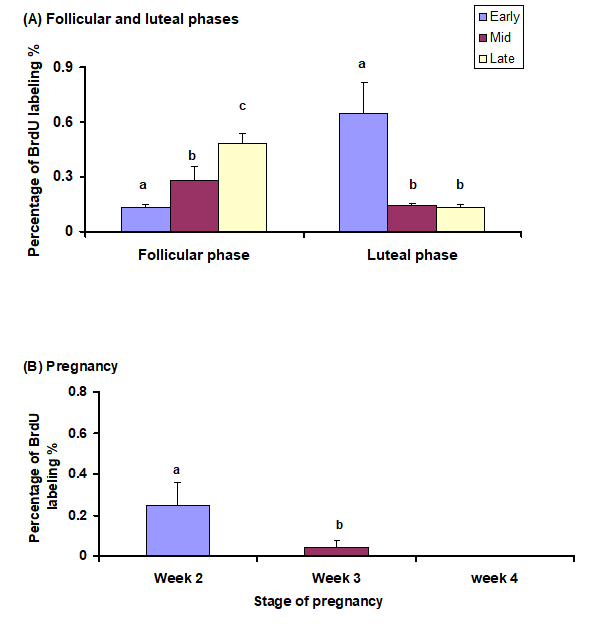
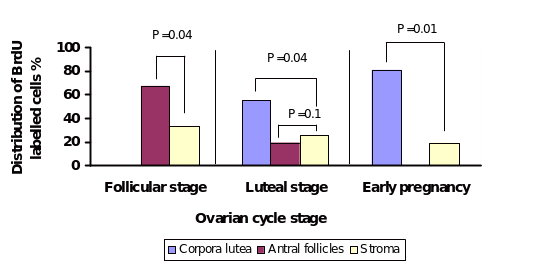
Figure 5.2 Distribution of proliferating cells within the OSE layer of marmoset ovary during the cycle (follicular and luteal stagessstages) and early pregnancy (week 2-3). Distribution of BrdU labelling labeling within the OSE cells through different regions, over corpora lutea (n =20), growing antral follicles (n =26), and over ovarian stroma (400 cells/section; n =22 sections). Values are the total percentage of BrdU labelling labeling at each region.
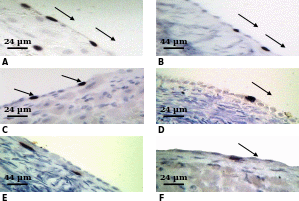
BrdU labelling labeling within the OSE cells at the follicular phase of the ovulatory cycle (A) over large antral follicle and (B) over stroma. C-D demonstrate demonstrates the morphology of OSE cells at luteal phase (C) over mature CL and (D) over stroma. E-F OSE cells at pregnancy (E) over stroma and (F) over CL. Arrows indicate labelled labeled cells (black stain).
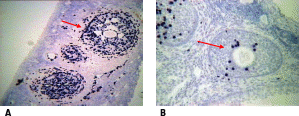
Histological sections at (A) follicular phase of the ovulatory cycle (red arrow indicates a high level of BrdU labelling labeling in granulosa cells of the antral follicle) and (B) at pregnancy (red arrow indicates a low level of BrdU labelling labeling in granulosa cells of the preantral follicle), A at 40X and B at 200X magnification.
Morphological changes in the OSE cells
The distribution of proliferation marker markers in OSE cells considerably varied during different reproductive stages (follicular, luteal, and pregnancy). The OSE morphology and its adhesiveness to underlying tissues are also expected to modify considering the extent of multiplication capabilities within a limited surface area in which the cells can expand. The microscopic observation revealed considerable variation in the shape of the OSE cells ranging from squamous to cuboidal.
Moreover, the association between the OSE cells was affected by the ovarian cycle and the ovarian compartments. OSE cells over the large antral follicles which were located very close to the surface were flattened in shape and disarrangement between these cells was noticed. There was no evidence of firm attachment with the underneath basement membrane (Figure 5.5-A).
Over the CL, OSE cells appeared as squamous with a very weak association between the cells, and it was seen that attachment of these cells with the basement membrane was also loose (Figure 5.5-B). The OSE cells observed in a region away from the follicular development and the ovarian event that is over the stroma, displayed highly organised organized topology of cuboidal shape, and attachment in between the cells and of the cells with underneath basement membrane was also firm (Figure 5.5-C)
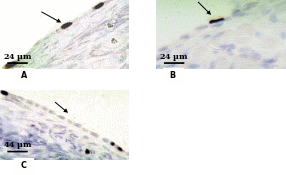
(A) OSE covering covers large antral follicle follicles (arrow indicates flattened shaped cells), (B) over a mature CL (arrow indicates squamous shaped cells), and (C) over ovarian stroma (arrow indicates cuboidal shaped cells).
Effecteffect of Antarelix treatment on OSE proliferation
Prior studies on Antarelix treatment in marmoset monkeys revealed a significant reduction in BrdU labelling labeling in ovarian endothelial cells and steroidogenesis in granulosa and theca cells of growing follicles (Taylor et al., 2004). It was a matter of interest to study how these changes would affect the overlaying OSE cells. A comparison of sections prepared from the ovaries of late follicular controls and the treatment groups revealed that the OSE cells of GnRH antagonist-treated ovaries from day 0-10 and from day 5-10 exhibited a decrease in the proliferation after both treatment schedules. Quantitative analysis confirmed a significant decrease in cell proliferation in the OSE cells in both treated groups, and the effect was more pronounced in longer treatment schedule (day 0-10 treated group; P =0.001) (Figure 5.6)

Discussion
Considering the fundamental role of OSE cells in ovarian tumorigenesis, the growth regulation of normal and neoplastic OSE cells by intraovarian regulators may play an important role in ovarian cancer development. In this regard, GnRH has been implicated as an autocrine regulator of normal OSE (Kang et al., 2000) as well as a growth inhibitor of ovarian cancer cells (Emons et al., 1993; Yano et al., 1994).
GnRH antagonists are widely used in the clinic during ovarian hyperstimulation programmes programs to block endogenous gonadotropin secretion (Huirne et al., 2004). GnRH regulates the biosynthesis and secretion of gonadotropins. In this study, we have demonstrated two significant finding findings regarding the OSE cells proliferation, in response of to GnRH antagonist treatment and under the effects of pregnancy. We provide evidence that GnRH antagonist treatment and pregnancy both significantly affect the proliferative activity of the OSE.
From the present results it appears that during the ovulatory cycle, BrdU staining of the OSE layer increases towards the end of the follicular phase, when it is in contact with large antral follicles, and decreases from mid lutealthe mid-luteal phase, when CL starts to recede. In fact theThe highest staining was seen in CL at the early luteal phase and during early pregnancy. Low staining of OSE, layering stroma suggests that the resting OSE cells at early follicle development or those which are not in the vicinity of the CL or antrum are not profusely dividing. Since OSE proliferation was associated with late follicles and CL at all reproductive phases it can be predicted that events leading to luteogenesis contribute towards OSE proliferation whereas the reverse process, luteolysis, suppresses the proliferative response.
During luteogenesis remarkable changes take place in the granulosa and theca cells of growing follicles in the late follicular phase, notably vascularization, angiogenesis and steroidogenesis. Interestingly, these changes are regulated by LH/CG (Taylor et al., 2004; Duncan et al., 2009). Angiogenesis is tightly regulated by an endogenous cellular factor called vascular endothelial growth factor (VEGF). In granulosa cells of growing follicles, VEGF expression is up-regulated most likely due to LH, and a high cellular level of this factor is maintained up to luteal phase controlled by LH/CG.
In CL the same granulosa cells transform to granulosa-lutein cells responsible for steroidogenesis. It was therefore a matter of interest to examine whether or not the angiogenic and steroidogenic granulosa cells proliferate at the late follicular and early luteal phase. The granulosa cells of growing follicles were heavily stained suggesting that these cells are multiplying and transforming to micro-vascular cells. We propose that these rapidly multiplying granulosa cells secrete some mitogenic substances, notably β-estradiol, to influence the surrounding OSE layer to proliferate.
OSE cell morphology is believed to be another marker of proliferative activity (Auersperg et al., 2001). It has been suggested that squamous and cuboidal forms of cells represent the groups that have not or have undergone post-ovulatory proliferation respectively. OSE cells tend to assume columnar shapes when they form clefts and inclusion cysts. These cells are the primary targets for mitogenic and inflammatory action leading to tumorigenic growth.
Besides, the secretion of adhesive proteins like cadherins determine the association of the OSE layer with the underneath basement membrane. We found that non-proliferative cuboidal and tightly attached OSE cells were present away from the ovulation sites. The proliferative squamous cells with very loose attachment were discernable over CL and disarranged flattened cells were present in the OSE layer just before ovulation. Some of these cells might transform to columnar cells if inclusion cysts or clefts are formed after ovulation.
Since OSE cells and neighbouring neighboring pre-antral follicles’s follicles’ granulosa cells during 2nd week of pregnancy also displayed positive BrdU staining, it is obvious that the proliferation is not necessarily related to only post-ovulatory rupture of the OSE layer. It was rather surprising to detect OSE proliferation in proximity to CL and granulosa cells of pre-antral follicles during early pregnancy. This was because the progesterone concentration must have been high enough to suppress any proliferative action. Earlier we have shown an anti-proliferative role of progesterone whether produced during pregnancy or is given as contraceptive pills.
It is reasonable to assume that despite progesterone presence, CL influences the OSE proliferation and this attribute could be due to some factor which that supersedes the hormone action. The data also suggests that as pregnancy advances the proliferation becomes diminished because the regression of CL eliminates the factor which overrides the progesterone effect.
So far the results indicate that in marmoset luteogenesis rather than folliculogenesis seems to influence OSE proliferation and luteolysis and pregnancy reverses reverse this process. In primates, LH/CG is necessary for CL development, which induces numerous paracrine regulations for luteal development including VEGF that controls angiogenesis and vascularization (Duncan et al., 2009). As LH concentration starts to recede, the natural luteolysis advances starting from the mid lutealmid-luteal phase. During luteolysis, the LH level falls, and all its stimulatory actions like angiogenesis and steroidogenesis invertsare inverted.
Besides, luteal cells also produce interleukins, prostaglandins, and factors like capsasecaspase-3 to induced induce apoptosis and other mechanisms to degenerate CL (Fraser et al., 2006). If CL is rescued due to pregnancy, CG produced from conceptus takes over the LH functions. In this investigation, the granulosa proliferation in CL during early luteogenesis and at early pregnancy appears to be the result of LH/GC-mediated up-regulation of VEGF and other luteonizing luteinizing factors and steroid production, a process that is reversed during luteolysis.
It remains to be seen whether in primates local ovarian environment influence OSE proliferation or it is simply the mechanical ablation of the OSE layer to accommodate large antrum or CL that triggers the renewed multiplication and neoplastic transformation. In this context, it is noteworthy that in rhesus monkeys brushing the OSE layer at any reproductive phase is a good enough reason to induce proliferative repair (Wright et al., 2007).
In this investigation, the potential anti-proliferative response to treatment with a GnRH antagonist was examined on OSE cells in marmoset monkeys. Prior toBefore this experiment, the CL was artificially degeneratedartificially degenerated and the luteal phase was prematurely stopped by treatment of of prostaglandin F2α analogue analog towards the end of the ovulatory cycle, which is a common practice to synchronize follicular phase in cycling marmosets (Steinetz et al., 1995).
Luteolysis was verified as a sharp reduction in serum progesterone concentration (Taylor et al., 2004). Towards the end of luteolysis the steroidal hormones reach their minimum concentrations and under LH/CG influence the steroidogenesis begins in pre-antral granulosa and antral granulosa and theca cells. Blocking FSH and LH/CG release at zero time by Antarelix (0-10 days) in this study would have arrested the development of tertiory tertiary follicles and consequent ovulation was averted (Taylor et al., 2004). Further, β-estradiol synthesis was decreased as Antarelix treatment inhibits steroidogenesis (Taylor et al., 2004).
At 5th day blockage (5-10 days) some gonadotropin concentration would have build built up in within the first 5 days which apparently is sufficient to grow follicles up to the pre-antral stage. Thereafter, LH “surge” which takes place after 5 days in the follicular cycle necessary for ovulation and CL formation must have been prevented. Since in marmosets large antra are differentiated only after 6 days (Gilchrist et al., 2001), possibly in this treatment regime, neither large antrum would be differentiated nor CL would be formed. In this situation, only the small antral follicles are expected to develop and then start to regress into atresia (Taylor et al., 2004).
The depressive effect of Antarelix on OSE proliferative activity was clearly discernable regardless of the time of administration. It is proposed that pre-ovulatory large antrum and its derived CL may be responsible for OSE proliferation in the contact regions. This conclusion is derived from observed OSE proliferation was suppression suppressed when the drug was administered on the 5th day of the follicular cycle when only pre-ovulatory follicles were not able to be differentiated. There could be several explanations of Antarelix’s OSE anti-proliferative effect which may function in isolation or in combination:
- reversal of LH/CG up-regulation of localized growth factors like IGF and HGF which are responsible for mitogenic action through their anti-apoptotic effect on OSE,
- inhibition of gonadotropin-induced steroidogenesis in antral follicles and CL would minimize production of mitogenic β-estradiol in granulosa cells, and consequently OSE proliferation would be averted,
- GnRH antagonists result in skew in frequency of antral follicles (Taylor et al., 2004), and apparently this would reduce ovulation frequencies and resultant epithelial rupture, and thereby prevent the neoplastic growth of OSE, and
- this compound may bind to GnRH-I/ GnRH-II receptors in OSE cells itself and inhibit all downstream pathways which involve mitogen activating protein (MAP), P38 and the extracellular signal regulate kinase (ERK-1/2) responsible for mitogenic proliferation (Millar et al., 2001; Mamputha et al., 2007).
In conclusion, BrdU immuoreactivity immunoreactivity was detected at the ovulation site before and after ovulation and a lower number of BrdU–stained cells were found to be distributed randomly around the ovary, suggesting that the OSE proliferative activity takes place in a cyclic mannercyclically takes place depending on the ovarian events that occur underneath the OSE during the ovarian cycle. GnRH antagonist treatment resulted in complete inhibition of OSE cells proliferation. Further study is needed for investigating the mechanisms in which the GnRH antagonist exerts its effect on OSE cells, whether by direct or indirect pathway.